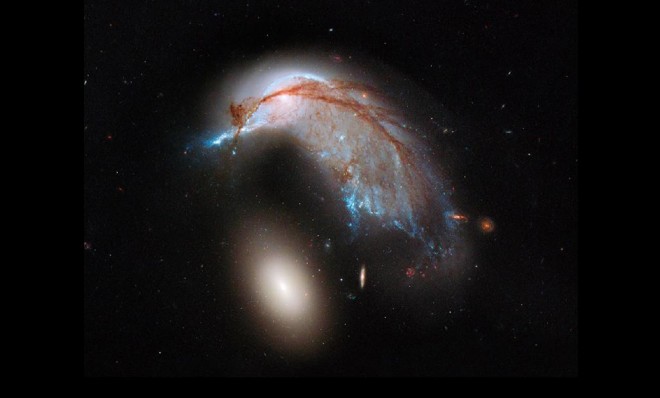A gigantic galaxy shaped like a penguin
It has an egg, too

About 400 light years away, tucked away in the constellation Hydra, sit a pair of galaxies unlike any we've seen before. NGC 2936, on the right, looks like a massive, blue-tinged penguin. Its smaller, elliptical companion, NGC 2937, resembles an egg.
Together, the pair are referred to as Arp 142 — named after the astronomer Halton Arp, who was famous for penning a book titled Atlas of Peculiar Galaxies.
The fact that the pair look the way they do isn't a mere coincidence. Astronomers theorize that the gravitational tug of the smaller egg-shaped system is what's responsible for giving its neighbor its bird-like shape. According to NASA, this dynamic is what's warping NGC 2936's "orderly spiral," as its interstellar gas is "strewn out into giant tails like stretched taffy." Eventually, Arp 142 may become a single, supermassive system, a phenomenon we've actually seen before.
The Week
Escape your echo chamber. Get the facts behind the news, plus analysis from multiple perspectives.

Sign up for The Week's Free Newsletters
From our morning news briefing to a weekly Good News Newsletter, get the best of The Week delivered directly to your inbox.
From our morning news briefing to a weekly Good News Newsletter, get the best of The Week delivered directly to your inbox.
By the time the pair do smash into one another, the Earth will likely be long gone — flightless birds and all.
A free daily email with the biggest news stories of the day – and the best features from TheWeek.com
-
 Political cartoons for December 13
Political cartoons for December 13Cartoons Saturday's political cartoons include saving healthcare, the affordability crisis, and more
-
 Farage’s £9m windfall: will it smooth his path to power?
Farage’s £9m windfall: will it smooth his path to power?In Depth The record donation has come amidst rumours of collaboration with the Conservatives and allegations of racism in Farage's school days
-
 The issue dividing Israel: ultra-Orthodox draft dodgers
The issue dividing Israel: ultra-Orthodox draft dodgersIn the Spotlight A new bill has solidified the community’s ‘draft evasion’ stance, with this issue becoming the country’s ‘greatest internal security threat’